Research
Last summer, I canned for the first time with fellow UGooders and loved sharing and eating the spicy pickles and peach blackberry jam we created. While both received many compliments, I knew I’d be nowhere without our fearless leader Louise’s technical expertise in the kitchen. As for pickled veggies I haven’t made myself; pickled onions have turned many a salad from mediocre to magnificent, and from a health perspective, I’ll take all the probiotics I can get. As soon as I saw this DIY Fermentation Kit come into the UncommonGoods assortment, I had to try it for myself.
Hypothesis
I’ve never particularly liked traditional sauerkraut, but the kit included a recipe for a special golden variety that uses turmeric, fennel seeds, and other rich spices that I’ve read somewhere are good for my health. While I’m not necessarily a natural in the kitchen, I’ve taken a peek at the instructions and it looks like I’m in good hands. Leaving about ten days for the veggies to ferment, I’m optimistic this will be a tasty and successful experiment. If nothing else, it will be a good excuse to gather friends for a potluck dinner. Equipped with a hearty head of organic cabbage and a healthy dose of anxiety, I’m ready to begin!
Experiment
I first survey my ingredients to see what needs prepping. The recipe calls for 1 ½ lb of cabbage and I do not have a kitchen scale. Luckily, a quick google search saves the day and I get to chopping.
Next, I throw all my cabbage into what looks like a witches’ cauldron that I found in my cabinet. I massage salt into the cabbage for five minutes.
After grating and chopping the remaining ingredients, (onion, ginger, cilantro) my kitchen starts to look like a war zone. Everything is about ready to be loaded in with the cabbage and thoroughly mixed. Once everything is combined, it takes on the golden hue of the turmeric that gives this sauerkraut its name. I’ve had to make a few judgment calls along the way** but nothing that I think will jeopardize the fermentation experiment.
As I prepare to load the cabbage mixture into the mason jar, I discover a small packet labeled “Golden Spice Blend” as well as a sizable package of high-quality sea salt. Never did the recipe mention that this was included! (And I admittedly glossed over the second photo on the item page.) After kicking myself for having already bought, measured, and improvised on some of the ingredients, I decide to be thankful for an opportunity to try again and stash the packet in my cupboard.
After loading the cabbage mixture and brine (boiled water + salt) into the mason jar, I very carefully (and multiple times) read the instructions for how to fasten the lid onto the jar. I then pour some water on top of the lid to provide a “moat” and leave my experiment in an out-of-the-way corner of the kitchen. Memorial Day Weekend here I come!
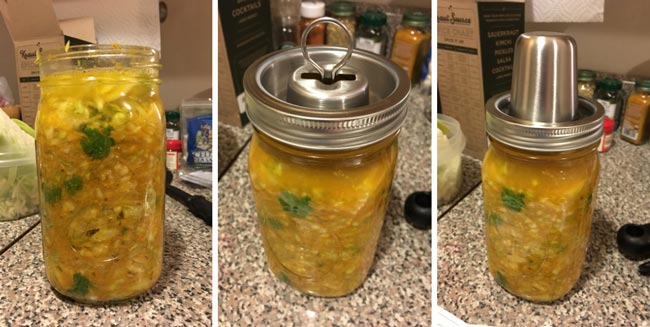
Two days after my experiment has begun I receive a text from my roommate:
 Panicked, unable to help, I dart to the FAQ section of the Krautsource website and ask him to drain some of the liquid and reattach the lid. This is apparently common with water-heavy veggies like cabbage and the mere presence of this issue on the FAQ section helps to ease my mind. For future fermenters, allow your cabbage mixture to ferment without brine for 24 hours as it may not even be necessary. Good to know for next time!
Panicked, unable to help, I dart to the FAQ section of the Krautsource website and ask him to drain some of the liquid and reattach the lid. This is apparently common with water-heavy veggies like cabbage and the mere presence of this issue on the FAQ section helps to ease my mind. For future fermenters, allow your cabbage mixture to ferment without brine for 24 hours as it may not even be necessary. Good to know for next time!
With this crisis behind me, I make a plan for feeding my homemade sauerkraut to my friends. Using our weekly Sunday TV night as the vehicle, I ask everyone to arrive a little early and bring a hot dog of their choosing. As long as I don’t poison them (and especially if I do), I can count on my friend group to be honest about my work.
Conclusion
So as not to actually poison my friends, I agree to take the first bite of sauerkraut before the veggie dogs and sides are done cooking. My first word is “potent!” I’ll admit sauerkraut is not the best on its own, and decide not to rush to any judgments until the full feast is ready.
Luckily, our sauerkraut tasting turns into a full-fledged potluck, with sides of carrots, cauliflower mashed potatoes, and chips and salsa rounding out our veggie dog creations. This provides an opportunity to mix different flavors and textures.
As we dig in, I record soundbites of my friends’ reactions:
Joel: “Totally funky!”
Neha: “I like it! But I like pickled anything.”
Jen: “Very pickle-y.”
Charles: “Mmm, interesting. Undoubtedly the best sauerkraut I’ve ever had.”
Joey: “I like it. I like it more than I thought I would!”

Though Charles was pretty sure he’d never had sauerkraut before, I took the varying degrees of satisfaction as success — plus I saw him get up for seconds. In the end, the sauerkraut tasted best with the veggie dogs and the cauliflower mashed potatoes, anywhere a more subtle flavor could use a real kick. Different people picked up on different spices with each bite, from the curry-esque cumin to the licorice-like fennel seeds. In hindsight, I may have tested a more traditional sauerkraut recipe and used a vegetable other than cabbage that took less time to chop. Typing this over twelve hours after the taste test, I can confirm no one was poisoned. Overall, I can’t wait to try my next fermentation! And hopefully my friends can’t, either.
**For the dedicated reader, a brief list of improvisations, which may or may not have affected the outcome:
–not realizing the spices were provided, I used powdered cumin rather than cumin seeds as the recipe calls for. I also use a slightly lower quality salt than I wish I had.
–by the time I’m grating the ginger I’m too tired to measure. Confession: I eyeballed it.
–the printed recipe that comes with the product calls for yellow onions, but on the Krautsource website the recipe lists green onions. These are very different onions, and I wonder if green onions would have been a better choice.
–the printed recipe just says “add brine” and does not define brine for you. An online search reveals that brine = 1 teaspoon salt: 1 cup of water. The kit also doesn’t warn you that you should ferment the cabbage without brine to prevent overflow. I only learned that the hard way and through the FAQ section.

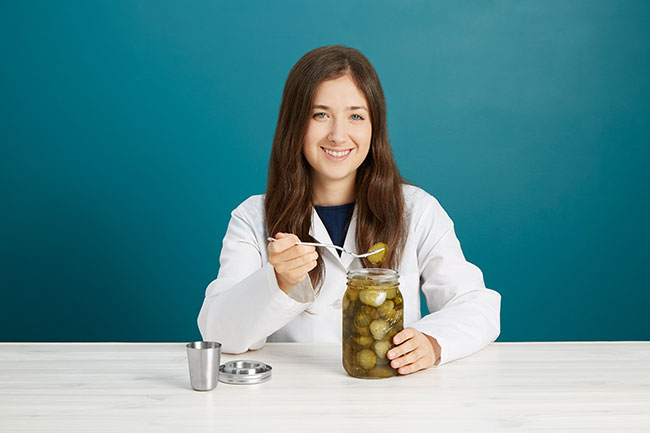

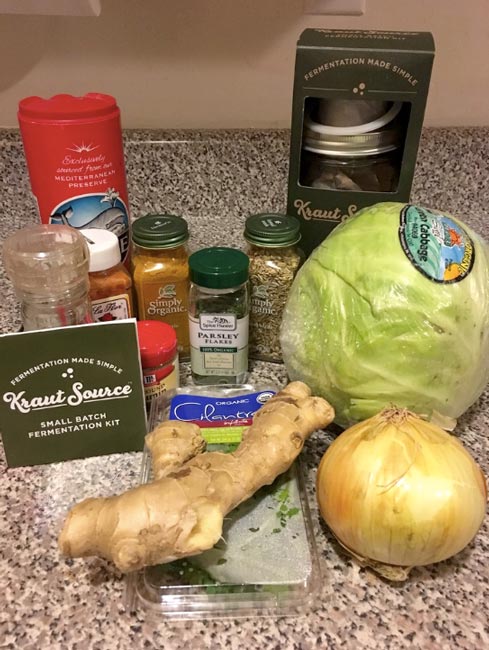

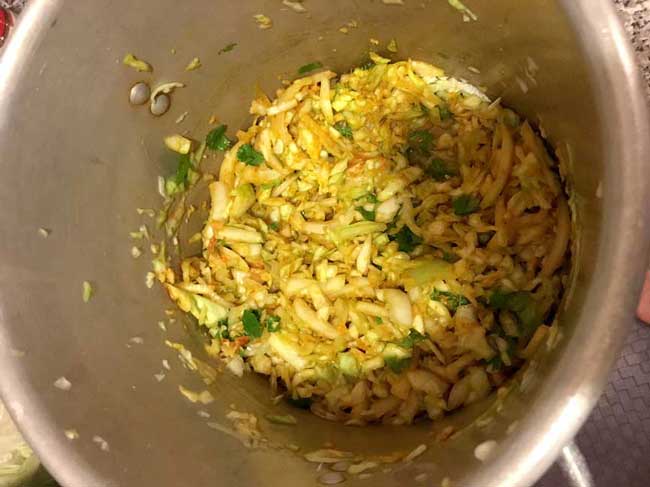
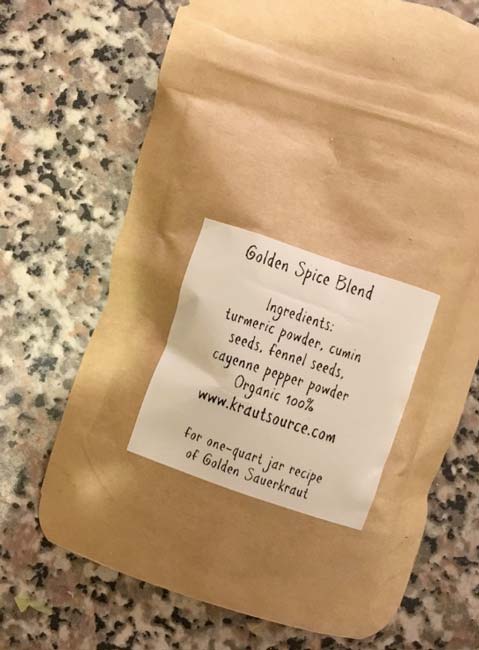


No Comments